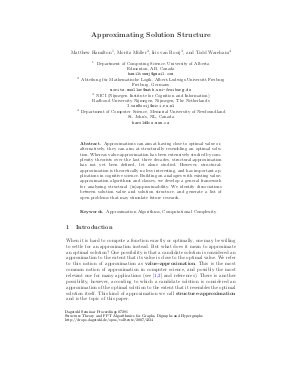Approximating Solution Structure
Authors Iris van Rooij, Matthew Hamilton, Moritz Müller, Todd Wareham
-
Part of:
Volume:
Dagstuhl Seminar Proceedings, Volume 7281
Part of: Series: Dagstuhl Seminar Proceedings (DagSemProc) - License:
 Creative Commons Attribution 4.0 International license
Creative Commons Attribution 4.0 International license
- Publication Date: 2007-11-28
File

PDF
DagSemProc.07281.3.pdf
- Filesize: 261 kB
- 24 pages
Document Identifiers
Subject Classification
Keywords
- Approximation Algorithms
- Solution Structure
Metrics
- Access Statistics
-
Total Accesses (updated on a weekly basis)
0Document
0Metadata
Abstract
hen it is hard to compute an optimal solution $y in optsol(x)$ to an
instance $x$ of a problem, one may be willing to settle for an efficient
algorithm $A$ that computes an approximate solution $A(x)$. The most
popular type of approximation algorithm in Computer Science (and indeed
many other applications) computes solutions whose value is within some multiplicative factor of the optimal solution value, {em e.g.},
$max(frac{val(A(x))}{optval(x)}, frac{optval(x)}{val(A(x))}) leq
h(|x|)$ for some function $h()$. However, an algorithm might also
produce a solution whose structure is ``close'' to the structure of an
optimal solution relative to a specified solution-distance function $d$,
{em i.e.}, $d(A(x), y) leq h(|x|)$ for some $y in optsol(x)$. Such
structure-approximation algorithms have applications within Cognitive
Science and other areas. Though there is an
extensive literature dating back over 30 years on value-approximation,
there is to our knowledge no work on general techniques for assessing
the structure-(in)approximability of a given problem.
In this talk, we describe a framework for investigating the
polynomial-time and fixed-parameter structure-(in)approximability of
combinatorial optimization problems relative to metric solution-distance
functions, {em e.g.}, Hamming distance. We motivate this framework by
(1) describing a particular application within Cognitive Science and (2)
showing that value-approximability does not necessarily imply
structure-approximability (and vice versa). This framework includes
definitions of several types of structure approximation algorithms
analogous to those studied in value-approximation, as well as
structure-approximation problem classes and a
structure-approximability-preserving reducibility. We describe a set of techniques for proving the degree of
structure-(in)approximability of a given problem, and summarize all
known results derived using these techniques. We also list 11 open
questions summarizing particularly promising directions for future
research within this framework.
vspace*{0.15in}
oindent
(co-presented with Todd Wareham)
vspace*{0.15in}
jointwork{Hamilton, Matthew; M"{u}ller, Moritz; van Rooij, Iris; Wareham, Todd}
Cite As Get BibTex
Iris van Rooij, Matthew Hamilton, Moritz Müller, and Todd Wareham. Approximating Solution Structure. In Structure Theory and FPT Algorithmics for Graphs, Digraphs and Hypergraphs. Dagstuhl Seminar Proceedings, Volume 7281, pp. 1-24, Schloss Dagstuhl – Leibniz-Zentrum für Informatik (2007)
https://doi.org/10.4230/DagSemProc.07281.3
BibTex
@InProceedings{vanrooij_et_al:DagSemProc.07281.3,
author = {van Rooij, Iris and Hamilton, Matthew and M\"{u}ller, Moritz and Wareham, Todd},
title = {{Approximating Solution Structure}},
booktitle = {Structure Theory and FPT Algorithmics for Graphs, Digraphs and Hypergraphs},
pages = {1--24},
series = {Dagstuhl Seminar Proceedings (DagSemProc)},
ISSN = {1862-4405},
year = {2007},
volume = {7281},
editor = {Erik Demaine and Gregory Z. Gutin and Daniel Marx and Ulrike Stege},
publisher = {Schloss Dagstuhl -- Leibniz-Zentrum f{\"u}r Informatik},
address = {Dagstuhl, Germany},
URL = {https://drops.dagstuhl.de/entities/document/10.4230/DagSemProc.07281.3},
URN = {urn:nbn:de:0030-drops-12345},
doi = {10.4230/DagSemProc.07281.3},
annote = {Keywords: Approximation Algorithms, Solution Structure}
}
